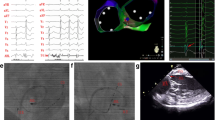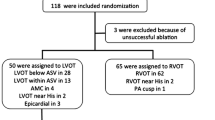Abstract
Purpose
Differentiating between atrioventricular nodal reentrant tachycardia (AVNRT) and non-reentrant junctional tachycardia (JT) is difficult but highly necessary for catheter ablation. The purpose of this study was to investigate whether the ventriculoatrial (VA) relationship after atrial overdrive pacing (AOP) could help to distinguish AVNRT from JT.
Methods
Thirty-eight AVNRT and 21 JT patients who were induced by infusion of isoproterenol after successful AVNRT ablation were paced through the high right atrium or coronary sinus until the ventricles were constantly captured. After the pacing was stopped, the intervals of postpacing VA (VAP) and tachycardia VA (VAT) were measured if the pacing did not terminate tachycardia.
Results
Thirty-five (92.1 %) cases were captured by 119 AOPs (119/175) without terminating tachycardia in the 38 cases of AVNRT. Of the 35 cases, 34 (97.1 %) showed VAP-VAT < 22.55 ms in all successful AOPs (116 times). The remaining case showed VAP-VAT > 294.9 ms in one AOP and VAP-VAT < 22.55 ms in two AOPs. All 21 JT cases could be captured successfully by all (105/105) AOPs and showed VAP-VAT > 294.9 ms. VAP-VAT < 22.55 ms had 118/118 (100 %) specificity for AVNRT, and the VAP-VAT > 294.9 ms response was 105/105 (100 %) sensitive for JT.
Conclusions
The VA relationship after AOP could help distinguish AVNRT from JT. VAP-VAT < 22.55 ms was specific for AVNRT, and VAP-VAT > 294.9 ms for JT in the overwhelming majority, except for the rare instance of AVNRT with a double ventricular response.



Similar content being viewed by others
References
Hamdan M, Van Hare GF, Fisher W, Gonzalez R, Dorostkar P, Lee R, et al. Selective catheter ablation of the tachycardia focus in patients with nonreentrant junctional tachycardia. Am J Cardiol. 1996;78:1292–7.
Jackman WM, Beckman KJ, McClelland JH, Wang X, Friday KJ, Roman CA, et al. Treatment of supraventricular tachycardia due to atrioventricular nodal reentry, by radiofrequency catheter ablation of slow-pathway conduction. N Engl J Med. 1992;327:313–8.
Knight BP, Ebinger M, Oral H, Kim MH, Sticherling C, Pelosi F, et al. Diagnostic value of tachycardia features and pacing maneuvers during paroxysmal supraventricular tachycardia. J Am Coll Cardiol. 2000;36:574–82.
Maruyama M, Kobayashi Y, Miyauchi Y, Ino T, Atarashi H, Katoh T, et al. The VA relationship after differential atrial overdrive pacing: a novel tool for the diagnosis of atrial tachycardia in the electrophysiologic laboratory. J Cardiovasc Electrophysiol. 2007;18:1127–33.
Sarkozy A, Richter S, Chierchia GB, De Asmundis C, Seferlis C, Brugada P, et al. A novel pacing manoeuvre to diagnose atrial tachycardia. Europace. 2008;10:459–66.
Gonzalez MD, Banchs JE, Rivera J. Ablation of atriventicular nodal reentrant tachycardia and variants. In Huang Shoei K, Wood Mark A, editors. Cather ablation of cardiac arrhythmias. 2nd ed. Philadelphia: Elsevier; 2011. p. 318–59.
Fan R, Tardos JG, Almasry I, Barbera S, Rashba EJ, Iwai S. Novel use of atrial overdrive pacing to rapidly differentiate junctional tachycardia from atrioventricular nodal reentrant tachycardia. Heart Rhythm. 2011;8:840–4.
Srivathsan K, Gami AS, Barrett R, Monahan K, Packer DL, Asirvatham SJ. Differentiating atrioventricular nodal reentrant tachycardia from junctional tachycardia: novel application of the delta H-A interval. J Cardiovasc Electrophysiol. 2008;19:1–6.
Padanilam BJ, Manfredi JA, Steinberg LA, Olson JA, Fogel RI, Prystowsky EN. Differentiating junctional tachycardia and atrioventricular node re-entry tachycardia based on response to atrial extrastimulus pacing. J Am Coll Cardiol. 2008;52:1711–7.
Lane C, Veenhuyzen GD, Quinn FR. A conflict of evidence: AVNRT or junctional tachycardia? Heart Rhythm. 2013;10:767–9.
Tokuda M, Yamane T, Matsuo S, Tokutake K, Yokoyama K, Hioki M, Narui R, Tanigawa SI, Yamashita S, Inada K, Yoshimura M. Paradoxical responses to pacing maneuvers differentiating atrioventricular node reentrant tachycardia and junctional tachycardia. Heart and Vessels. 2016;31(2):256–60.
Philips B, Berger RD, Marine JE. Response to atrial extrastimulus during supraventricular tachycardia: what is the mechanism? J Cardiovasc Electrophysiol. 2013;24:359–63.
Author information
Authors and Affiliations
Corresponding author
Ethics declarations
All patients gave an informed written consent before EPS and radiofrequency ablation were performed. The study protocols were approved by the Medical Ethics Committee at Sun Yat-Sen University before initiation of the study.
Conflict of interest
The authors declare that they have no conflict of interest.
Additional information
Lichun Wang and Jingzhou Jiang contributed equally to this work.
Rights and permissions
About this article
Cite this article
Wang, L., Jiang, J., Su, C. et al. The ventriculoatrial relationship after atrial overdrive pacing can help differentiate atrioventricular nodal reentrant tachycardia from junctional tachycardia. J Interv Card Electrophysiol 47, 293–298 (2016). https://doi.org/10.1007/s10840-016-0178-6
Received:
Accepted:
Published:
Issue Date:
DOI: https://doi.org/10.1007/s10840-016-0178-6




